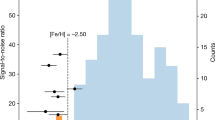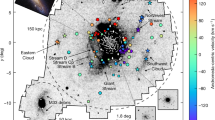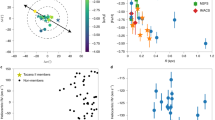Abstract
Recent observations have revealed streams of gas and stars in the halo of the Milky Way1,2,3 that are the debris from interactions between our Galaxy and some of its dwarf companion galaxies; the Sagittarius dwarf galaxy and the Magellanic clouds. Analysis of the material has shown that much of the halo is made up of cannibalized satellite galaxies2,4, and that dark matter is distributed nearly spherically in the Milky Way. It remains unclear, however, whether cannibalized substructures are as common in the haloes of galaxies as predicted by galaxy-formation theory5. Here we report the discovery of a giant stream of metal-rich stars within the halo of the nearest large galaxy, M31 (the Andromeda galaxy). The source of this stream could be the dwarf galaxies M32 and NGC205, which are close companions of M31 and which may have lost a substantial number of stars owing to tidal interactions. The results demonstrate that the epoch of galaxy building still continues, albeit at a modest rate, and that tidal streams may be a generic feature of galaxy haloes.
This is a preview of subscription content, access via your institution
Access options
Subscribe to this journal
Receive 51 print issues and online access
$199.00 per year
only $3.90 per issue
Buy this article
- Purchase on Springer Link
- Instant access to full article PDF
Prices may be subject to local taxes which are calculated during checkout


Similar content being viewed by others
References
Putman, M. E. et al. Tidal disruption of the Magellanic Clouds by the Milky Way. Nature 394, 752–754 (1998).
Ibata, R., Lewis, G. F., Irwin, M., Totten, E. & Quinn, T. Great circle tidal streams: evidence for a nearly spherical massive dark halo around the Milky Way. Astrophys. J. 551, 294–311 (2001).
Ibata, R., Irwin, M., Lewis, G. F. & Stolte, A. Galactic halo substructure in the Sloan Digital Sky Survey: The ancient tidal stream from the Sagittarius dwarf galaxy. Astrophys. J. 547, L133–L136 (2001).
Helmi, A., White, S. D. M., de Zeeuw, P. T. & Zhao, H. Debris streams in the solar neighbourhood as relicts from the formation of the Milky Way. Nature 402, 53–55 (1999).
Klyin, A., Gottlöber, S., Kravtsov, A. V. & Khokhlov, A. M. Galaxies in N-body simulations: Overcoming the overmerging problem. Astrophys. J. 516, 530–551 (1999).
Cole, S., Aragon-Salamanca, A., Frenk, C. S., Navarro, J. F. & Zepf, S. E. A recipe for galaxy formation. Mon. Not. R. Astron. Soc. 271, 781–806 (1994).
Eggen, O. J., Lynden-Bell, D. & Sandage, A. R. Evidence from the motions of old stars that the Galaxy collapsed. Astrophys. J. 136, 748–766 (1962).
Shang, Z. et al. Ring structure and warp of NGC 5907: Interaction with dwarf galaxies. Astrophys. J. 504, L23–L26 (1998).
Sackett, P. D., Morrison, H. L., Harding, P. & Boroson, T. A. A faint luminous halo that may trace the dark matter around spiral galaxy NGC 5907. Nature 370, 441–443 (1994).
Stanek, K. Z. & Garnavich, P. M. Distance to M31 with the Hubble Space Telescope and HIPPARCOS red clump stars. Astrophys. J. 503, L131–L134 (1998).
Irwin, M. & Lewis, J. INT WFS pipeline processing. New Astron. Rev. 45, 105–110 (2001).
Holland, S., Fahlman, G. G. & Richer, H. B. Deep HST V- and I-band observations of the halo of M31: Evidence for multiple stellar populations. Astron. J. 112, 1035–1045 (1996).
Rich, R. M., Mighell, K. J., Freedman, W. L. & Neill, J. D. Local Group populations with the Hubble Space Telescope. I. The M31 globular cluster G1=Mayall II. Astron. J. 111, 768–776 (1996).
Reitzel, D. B., Guhathakurta, P. & Gould, A. Isolating red giant stars in M31's elusive outer spheroid. Astron. J. 116, 707–722 (1998).
Walterbos, R. A. M. & Kennicutt, R. C. Multi-color photographic surface photometry of the Andromeda galaxy. Astron. Astrophys. Suppl. 69, 311–332 (1987).
Innanen, K. A., Kamper, K. W., van den Bergh, S. & Papp, K. A. The optical warp of M31. Astrophys. J. 254, 515–516 (1982).
Durrell, P. R., Harris, W. E., Pritchet, C. J. & Davidge, T. Photometry of the outer halo of M31. Am. Astron. Soc. Meeting 195, 4.04 (1999).
Ferguson, A. M. N., Gallagher, J. S. & Wyse, R. F. G. The extreme outer regions of disk galaxies. I. Chemical abundances of H II regions. Astron. J. 116, 673–690 (1998).
Lee, M. G. Stellar population is the central region of the dwarf elliptical galaxy NGC 205. Astron. J. 112, 1438–1449 (1996).
Young, L. M. & Lo, K. Y. The neutral interstellar medium in nearby dwarf galaxies. II. NGC 185, NGC 205, and NGC 147. Astrophys. J. 476, 127–143 (1997).
Hodge, P. W. The structure and content of NGC 205. Astrophys. J. 182, 671–696 (1973).
Bender, R., Paquet, A. & Nieto, J. Internal stellar kinematics of three dwarf ellipticals in the Local Group. Astron. Astrophys. 246, 349–353 (1991).
Welch, G. A., Sage, L. J. & Mitchell, G. F. The puzzling features of the interstellar medium in NGC 205. Astrophys. J. 499, 209–220 (1998).
Freedman, W. L. Stellar content of nearby galaxies. II—the Local Group dwarf elliptical galaxy M32. Astron. J. 98, 1285–1304 (1989).
Davidge, T. J. The evolved red stellar content of M32. Publ. Astron. Soc. Pacif. 112, 1177–1187 (2000).
Grillmair, C. J. et al. Hubble Space Telescope observations of M32: The color-magnitude diagram. Astron. J. 112, 1975–1987 (1996).
Johnston, K. V., Spergel, D. N. & Hernquist, L. The disruption of the Sagittarius dwarf galaxy. Astrophys. J. 451, 598–606 (1995).
Ibata, R. A. & Lewis, G. F. Galactic indigestion: Numerical simulations of the Milky Way's closest neighbor. Astrophys. J. 500, 575–590 (1998).
Schwarzschild, M. Mass distribution and mass-luminosity ratio in galaxies. Astron. J. 59, 273–284 (1954).
Ibata, R. A. & Razoumov, A. O. Archer of the Galactic disk? The effect on the outer HI disk of the Milky Way of collisional encounters with the Sagittarius dwarf galaxy. Astron. Astrophys. 336, 130–136 (1998).
Acknowledgements
This paper is based on observations made with the Isaac Newton Telescope operated on the island of La Palma by the Isaac Newton Group in the Spanish Observatorio del Roque de los Muchachos of the Instituto de Astrofisica de Canarias.
Author information
Authors and Affiliations
Corresponding author
Rights and permissions
About this article
Cite this article
Ibata, R., Irwin, M., Lewis, G. et al. A giant stream of metal-rich stars in the halo of the galaxy M31. Nature 412, 49–52 (2001). https://doi.org/10.1038/35083506
Received:
Accepted:
Issue Date:
DOI: https://doi.org/10.1038/35083506
This article is cited by
-
Chemical and stellar properties of star-forming dwarf galaxies
Nature Astronomy (2022)
-
Destruction of the central black hole gas reservoir through head-on galaxy collisions
Nature Astronomy (2021)
-
Two major accretion epochs in M31 from two distinct populations of globular clusters
Nature (2019)
-
The Andromeda galaxy’s most important merger about 2 billion years ago as M32’s likely progenitor
Nature Astronomy (2018)
-
Toward an Internally Consistent Astronomical Distance Scale
Space Science Reviews (2017)
Comments
By submitting a comment you agree to abide by our Terms and Community Guidelines. If you find something abusive or that does not comply with our terms or guidelines please flag it as inappropriate.



